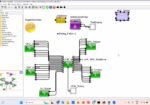You are currently viewing SemiWiki as a guest which gives you limited access to the site. To view blog comments and experience other SemiWiki features you must be a registered member. Registration is fast, simple, and absolutely free so please,
join our community today!
Dan is joined by Moshe Sheier, Ceva’s vice president of marketing. Moshe brings with him more than 20 years of experience in the semiconductor IP and chip industries in both development and managerial roles. Prior to this position, Mr. Sheier was the director of strategic marketing at Ceva.
Dan explores the history of Ceva with … Read More
Designing DSP Applications with Versal AI Engines Workshop
This workshop covers the AMD Versal AI Engine architecture and using the AI Engine DSP Library, system partitioning, rapid prototyping, and custom coding of AI Engine kernels. Developing AI Engine DSP designs using AMD Vitis Model Composer is also demonstrated.
The
…
Read More
Ceva recently unveiled its XC21 and XC23 DSP cores, designed to revolutionize wireless communications and edge AI processing. These new offerings build upon the Ceva-XC20 architecture, delivering unmatched efficiency, scalability, and performance for 5G-Advanced, pre-6G, and smart edge applications. As demand grows … Read More
I generally like to start my blogs with an application-centric viewpoint; what end-application is going to become faster, lower power or whatever because of this innovation? But sometimes an announcement defies such an easy classification because it is broadly useful. That’s the case for a recent release from Quadric, based… Read More
Field-Programmable Gate Arrays (FPGAs) have long been celebrated for their unmatched flexibility and programmability compared to Application-Specific Integrated Circuits (ASICs). And the introduction of Embedded FPGAs (eFPGAs) took these advantages to new heights. eFPGAs offer on-the-fly reconfiguration capabilities,… Read More
Semiconductor intellectual property (IP) plays a critical role in modern system-on-chip (SoC) designs. That’s not surprising given that modern SoCs are highly complex designs that leverage already proven building blocks such as processors, interfaces, foundational IP, on-chip bus fabrics, security IP, and others. This… Read More
During the GOMACTech conference held in South Carolina last week I had a Zoom call with Deepak Shankar, Founder and VP Technology at Mirabilis Design Inc. to ask questions and view a live demo of VisualSim – a modeling, simulation, exploration and collaborative platform to develop electronics and SoCs. What makes VisualSim so … Read More
Quadric Inc. is the leading licensor of general-purpose neural processor IP (GPNPU) that runs both machine learning inference workloads and classic DSP and control algorithms. Quadric’s unified hardware and software architecture is optimized for on-device ML inference. I have know Steve Roddy for many years, he is a high … Read More
The surge in Edge AI applications has propelled the need for architectures that balance performance, power efficiency, and flexibility. Architectural choices play a pivotal role in determining the success of AI processing at the edge, with trade-offs often necessary to meet the unique demands of diverse workloads. There are… Read More
I wrote previously that the debate over which CPU rules the world (Arm versus RISC-V) somewhat misses the forest for the trees in modern systems. This is nowhere more obvious that in intelligent audio and vision: smart doorbells, speakers, voice activated remotes, intelligent earbuds, automotive collision avoidance, self-parking,… Read More








